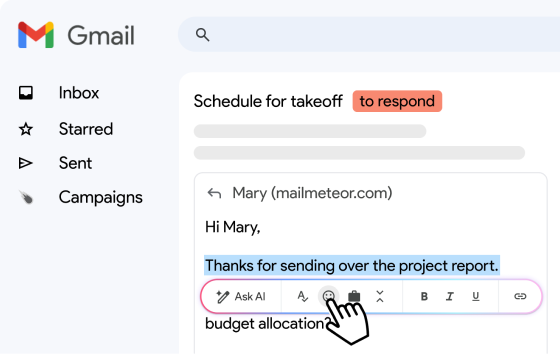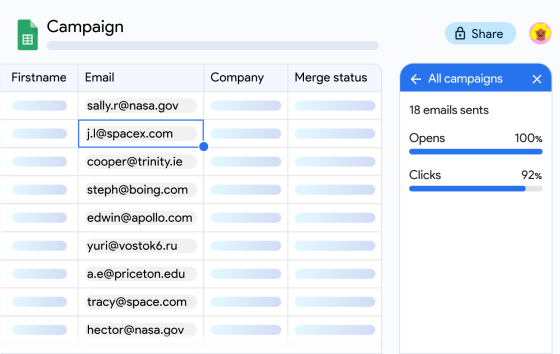If we haven’t said this one enough… Sending out email campaigns without tracking and analytics is as good as a shot in the dark. Tracking outreach efforts is critical for sales and marketing teams looking to optimize their strategies and end results. Using an outreach tracker provides valuable data and insights necessary to take decisions on strategy and tactics, which will make or break your outreach efforts.
This in-depth guide will cover everything you need to know about implementing an effective outreach tracking process:
- What is an Outreach Tracker and Why Use One?
- How to Choose the Right Outreach Tracker
- Best Practices for Using an Outreach Tracker
- Key Email Outreach Metrics to Track
- Tips to Boost Your Email Outreach Efforts
- Conclusion
- FAQs
Let’s dive in,
What is an Outreach Tracker and Why Use One?
An outreach tracker is a software tool that allows you to track and analyze your outreach campaigns across communication channels like email, phone calls, social media, and more. Outreach trackers provide important metrics and data to optimize your strategy.
Key Features and Capabilities
- Consolidates outreach data from all channels into one centralized platform
- Tracks opens, clicks, responses, meetings, and more
- Provides metrics like open rate, response rate, and conversion rate
- Enables you to segment and organize contacts
- Keeps detailed records of all outreach activities and results
- Surfaces insights to identify high-performing campaigns and areas needing improvement
Benefits of Using an Outreach Tracker
Improved Sales Performance
By tracking key metrics like calls-to-close ratios, outreach trackers give sales teams valuable data to understand what strategies convert best. This allows them to double down on high-performing approaches and continue optimizing to drive more sales.
Enhanced Lead Management
Outreach trackers help organize all lead information and interactions in one place. This supports better lead nurturing and prioritization so sales teams can focus on hot leads.
Increased Team Collaboration
With sales and marketing teams accessing a shared outreach tracking system, they can work together more efficiently. This alignment also provides more cohesive messaging and outreach across teams.
Actionable Insights to Refine Strategy
The comprehensive data and reporting provided by outreach trackers enable sales and marketing teams to pinpoint what’s working. They can then refine playbooks and campaigns to improve performance.
How to Choose the Right Outreach Tracker
With a crowded marketplace of outreach tracking tools, it can be daunting to select the right solution for your sales and marketing stack. Here are the most important factors to evaluate when choosing an outreach tracker:
Key Features to Look For
Email Integration
Seamless integration with email platforms like Gmail and Outlook enables easy tracking without switching between tools.
Customization
Look for trackers that allow you to customize campaigns, metrics, templates, and more to suit your specific tracking needs.
Ease of Use
An intuitive, user-friendly interface means any team member can adopt the tracker quickly without extensive training.
Contact Management
Robust contact organization, segmentation, and enrichment capabilities are essential.
Activity Tracking
Comprehensive tracking of emails, calls, meetings, and all engagement touchpoints is a must.
Types of Outreach Trackers
Google Sheets
Google Sheets can provide basic outreach tracking using formulas. However, it lacks more advanced features and customization.
CRM-Based Trackers
Many CRM platforms like Salesforce and HubSpot CRM offer integrated outreach tracking capabilities. This provides a unified system for managing contacts, deals, and outreach.
Standalone Tracking Software
Tools like Mixmax, Pipedrive, or Yesware focus specifically on outreach tracking across channels, with advanced functionality.
Solutions to Consider
There’s no shortage of tools and products out there designed to help you track your progress and results.
Our favorite, for its ease of use, ideal set of functionalities, we recommend you run your campaigns through Mailmeteor. Few can bundle mail-merge with attachments, personalization, filtering, scheduling, autopilot sending, importing HTMLs, integrations with your CRM platforms, AND email tracking.
Not only does Mailmeteor do all of the above, it does it beautifully, with productivity in mind, and centered around privacy.
Other solutions you can consider:
- HubSpot - All-in-one CRM with growing email and outreach tracking capabilities.
- Outreach - Top sales engagement platform with excellent tracking and analytics.
- Gmelius - Robust Gmail tracker and team collaboration platform with CRM functionality.
- RightInbox - Affordable all-in-one tracking and productivity tool for Gmail and G Suite.
- Mailtrack - Free email tracking for Gmail with opens, clicks, and location tracking.
Best Practices for Using an Outreach Tracker
To maximize value from your outreach tracker, it is essential to follow best practices around proper setup, usage, and ongoing management.
Regularly Enter and Maintain Data
The quality of your tracker insights depends on the quality of the data within it. Be sure to:
- Input outreach details frequently - Manually check campaign data like emails sent, opens, replies, meetings set into your tracker regularly to keep it up-to-date.
- Perform list cleaning - Check for invalid emails and remove inactive contacts periodically. Verify details like names, titles, and addresses.
- Consider automations/integrations - Connect your email and other communication platforms to automatically sync interactions into your tracker.
- Standardize data entry - Create uniform processes for capturing campaign details so data remains consistent.
By maintaining clean, current data, your tracker reporting will accurately reflect your outreach performance.
Review and Adjust Strategies Periodically
Treat your outreach tracker as the source of truth for optimizing your efforts.
- Assess campaign performance monthly or quarterly using tracker dashboards and reports.
- Identify areas that need improvement based on trends in key metrics and segments.
- Make necessary adjustments to outreach strategies and campaigns based on insights.
- Set goals and benchmarks to compare performance over time.
Regularly reviewing and adjusting ensures you continue improving your outreach approaches using data.
Provide Team Training and Support
Your team must be equipped to use the outreach tracker effectively:
- Provide formal onboarding and training on the tracker for all new users.
- Offer continued education as platform features evolve.
- Set up ‘How to’ documentation or videos for reference.
- Define processes for data entry, segmenting contacts, etc.
- Have platform experts offer ongoing support to answer any usage questions.
Proper training and support will maximize adoption and usage of your outreach tracker.
Key Email Outreach Metrics to Track
While outreach trackers consolidate data from all channels, email remains a top digital communication tool. Be sure to monitor these key email metrics:
- Open Rate – Percentage of emails opened out of total delivered. Higher open rates signal better email relevance.
- Click-Through Rate – Percentage of recipients who clicked links within emails. Shows content engagement.
- Conversion Rate – Percentage of recipients who completed a desired action, like filling out a form. Measures email effectiveness at driving conversions.
- Reply Rate – Percentage of recipients who replied to emails. Indicates your messages compel responses.
- Bounce Rate – Percentage of emails bounced back or not delivered. High bounce rates negatively impact deliverability.
- Email Sharing – Percentage of recipients who forwarded your emails. Displays wider reach and impact.
- List Growth Rate – The rate at which your contact list is expanding through lead generation. Important for gauging reach.
- Unsubscribe Rate – Percentage of recipients who opted out from your emails. Should be monitored to avoid high unsubscribes.
Tips to Boost Your Email Outreach Efforts
Email remains one of the most effective digital marketing channels for sales and marketing outreach. However, with crowded inboxes, it can be challenging to get your emails noticed and drive conversions.
Perform Regular A/B Testing
A/B testing, also known as split testing, is a powerful way to identify the optimal email variables that result in higher open and conversion rates. You should regularly test different:
- Email subject lines - Test subject line length, content, emojis, urgency.
- Email content variations - Test different offers, formats, lengths, styles.
- Email designs - Test different templates, layouts, images, buttons.
- Send times - Test different days of the week and times of day.
- Recipient lists - Test different segments and personas.
By methodically testing these elements, you’ll home in on the highest-converting combinations for your outreach. Use your outreach tracker to accurately measure the results of each A/B test variation.
Craft Compelling Subject Lines
Your subject line is the first impression recipients have of your email, so it must capture attention. Effective subject line best practices include:
- Being clear and concise - Get to the point quickly using key keywords.
- Using intrigue - Ask questions or create curiosity to entice opens.
- Incorporating numbers - Stats and figures can pique interest.
- Avoiding overly promotional language - Prevent spam filter triggers.
- Personalizing - Add first names or custom details.
- Keeping it short - Up to about 50 characters for max impact.
Personalize Email Content
Generic outreach emails are far less likely to resonate with recipients. Make content personal with:
- Custom introductions - Use research to reference specific recipient details.
- Relevant messaging - Highlight how you solve their unique problems.
- Segmentation - Send different content to different recipients based on attributes.
- Personalized subject lines - Include recipients’ names, companies, or locations.
- Personalized images - Include their headshot or company logo.
Personalized content demonstrates you value recipients as individuals, not just generic leads.
Follow Up Regularly
Don’t let cold emails go ignored. Consistent follow-up is key to nurturing relationships and driving conversions.
- Follow up on unopened emails after 3-5 days with new content.
- Vary subject lines and content to re-engage recipients.
- Maintain a helpful, professional tone - avoid sounding desperate.
- Note follow-up conversations in your outreach tracker.
- Set reminders to continue follow-up cadences.
Following up shows recipients you are invested in delivering value.
Leverage Multi-Channel Outreach
Do not limit outreach to email alone. Utilize multiple digital channels such as:
- LinkedIn - Send InMail and customized connection requests.
- Facebook - Initiate conversations through paid advertising or organic engagement.
- Twitter - Build conversations through likes, mentions, and DMs.
- SMS/Texting - Obtain consent first, then follow up via text.
Outreach across channels allows you to reach recipients however they prefer to engage digitally. Always track outreach in each channel with your platform.
If emails continue going unanswered, proactively switch to another channel. Multi-channel outreach greatly improves the odds of connecting with recipients.
Conclusion
Implementing a streamlined outreach tracking process delivers actionable data to optimize campaigns across channels. Choosing the right software solution tailored to your needs is critical. By following best practices around setup, usage, and management, you’ll maximize value from your tracker.
Regularly evaluating key metrics and fine-tuning your outreach strategy based on insights will lead to greater productivity, customer engagement, and business growth. This comprehensive guide provided tips and knowledge to revolutionize your outreach. With a robust outreach tracking foundation, you can continue optimizing campaigns to outpace competitors.
FAQs
What are the most important metrics to track for email outreach campaigns?
Key email outreach metrics include open rate, click rate, reply rate, bounce rate, and unsubscribe rate. Tracking these gives insight into campaign performance.
How can a CRM system help track outreach efforts?
CRMs like Salesforce and HubSpot provide integrated tools to track emails, calls, and meetings from one platform, giving a unified view of outreach.
What data should you input into an outreach tracker?
Outreach trackers should capture details like recipient name/email, communication channel, date, status, and notes on the interaction.
How often should you review outreach campaign metrics?
It’s recommended to assess outreach metrics on a consistent basis, such as weekly or monthly. This allows you to optimize efforts.
What tips can improve outreach campaign management?
Strategies like lead scoring, outreach personalization, targeted follow-ups, and multi-channel outreach can boost campaign management.


